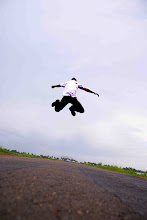Night Photography
Night photography has an attraction all its own. There's something about scintillating lights from office windows hanging in the dark of the night -- a modern version of the starry skies -- that appeal to us. Whether it's a city skyline, lamp posts on a dark and deserted street, or the front of your house all decked out with holiday lights, the challenge of capturing the mood of a night scene depends on whether your digital camera is capable of night photography and on a couple of simple techniques.Can My Camera Do Night Photography?
For successful night photography you need a digital camera that allows you to keep the shutter open for a long time, anywhere from 3 to 30 seconds. Check your camera specifications in the User's Manual under Shutter Speed. The shutter speeds available will be given as a range, e.g. 30 sec. - 1/2,000 sec.
If you are seriously into night photography, then you would want to ensure you purchase a digital camera that allows the longest shutter speed possible, and even Bulb (where the shutter remains open as long as you depress the shutter release button).
But before you plunk down your money for that digital camera, there's two more features to verify -- and one accessory to purchase, if you don't have it already.
Shooting Modes
For an image to be captured by a digital camera's image sensor, the latter requires exposure to light. But at night, light is what we don't have enough of.
Some of you may have noticed that, if you select a shooting mode of Auto (A) or Program Auto (P), your night pictures always come out too dark. They are simply underexposed. But, why is that -- if your camera's shutter speed ranges from, say 10 sec. to 1/2,000 sec.?
Go back to your camera's User's Manual and look a bit more carefully. Are all the shutter speeds available in Auto or P mode? Ah-ha, many digital cameras (we're talking consumer models here) do not make the whole shutter speed range available in A and P mode! Perhaps the slowest shutter speed available in A and P mode is only as slow as 1/3 sec. That's usually not long enough for night photography. To access the longer shutter speeds, you may need to select one of the other shooting modes, e.g. Shutter-Priority, or even switch to full Manual mode.
So ensure that your digital camera has full Manual mode and allows access to the full range of slow shutter speeds in that mode.
Self-Timer & Remote Controller
Another feature that you want your digital camera to have is a self-timer or, ideally, a remote controller. The purpose is to allow you to depress the shutter release button without introducing camera shake. I particularly like the remote controller, but not every camera comes with one or even has one available optionally.
But almost all, if not all, cameras has a self-timer. Usually the self-timer counts down from 10 sec. I find that a bit long to wait, especially since you would need to take more than one shot and it's minus 10 with the wind chill outside. The cameras that additionally provide a 2 sec. self-timer have my nod of approval here.
Tripod
A mandatory accessory that you need is a sturdy tripod. When you let the shutter stay open for a long time, the camera needs to be kept rock steady, otherwise you end up with blurred images.
Examples
OK, so we have our digital camera and tripod, and are ready to venture forth into the night in search for interesting night shots. When we find one, we set up camera and tripod, frame and... what do we do now?
Well, the images below show what happens when you take the same shot using P mode, then in Manual mode with various different shutter speed/aperture combinations, all in search of the correct exposure. The camera was on a tripod for all three shots.
| Programmed Auto Mode - Underexposed |
| Fujifilm FinePix E550 7.2mm, Programmed Auto, Pattern Shutter Speed 1/4 sec., Aperture F2.8, ISO 80 |
| Manual Mode - Overexposed |
| Fujifilm FinePix E550 7.2mm, Manual, Pattern Shutter Speed 3 sec., Aperture F2.8, ISO 80 |
Now it is just a matter of adjusting the shutter speed and/or aperture to obtain the desired exposure. I choose to close down the aperture so as to increase the depth of field also.
| Manual Mode - Correct Exposure |
| Fujifilm FinePix E550 7.2mm, Manual, Pattern Shutter Speed 3 sec., Aperture F4.0, ISO 80 |
ISO
For the three pictures above, I used ISO 80, the lowest ISO available for best image quality. But what if at 3 sec. and F2.8 (i.e. at max. exposure possible for this particular camera), the image still came out too dark? In this case, I would need to increase the sensitivity of the image sensor to a higher ISO. Do note that increasing the ISO also increases the amount of noise visible in your images.
Technique
Take a number of shots at different shutter speed/aperture combinations.
Immediately review the shot as soon as you've taken it.
Ensure your LCD brightness is set to Normal, not Bright, for a truer representation of your recorded image.
A good aperture to start with is F4.0 or F5.6 (for greatest depth of field), and adjust shutter speed up or down until you're satisfied with the shot.
For good measure, take an extra shot past your optimum exposure setting. For example, if you were progressively using longer shutter speeds, and you think you've find the correct one, take an extra shot with the next longer shutter speed. Conversely, if you were using progressively faster shutter speeds, take an extra shot using the next faster shutter speed.

